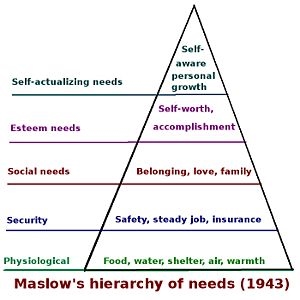 Image via Wikipedia
Image via WikipediaPart Two
Workplace Analysis
Maslow’s hierarchy of needs model was discussed in Part One. Part Two will focus on what this means in a workplace environment. It is important to realize again that people will be motivated by different levels at different times in their lives. Motivation is an area that is often spoken about by well meaning employers. The issue raises a lot of issues and questions for any employer looking for ways to motivate his/her workforce.
Level One: Physiological Needs: rarely are these issues raised in the modern workplace. However, construction crews and other businesses that work in the great outdoors often work in the elements and issues of thirst and protection from the elements can be an issue during extreme cold or heat. These are the most basic of needs and if not met all other needs are unimportant.
Level Two: Safety Needs – the ability to feel safe and protected is a basic human need. It does not take much imagination to see how this can be disturbed in the workplace. Workplace violence has become more frequent at least far as the media reports are concerned. Law suits involving sexual harassment, age discrimination and discrimination on the basis of race, gender and ethnicity also must be factored into this section. Many businesses have engaged in a lot of proactive training meant to minimize the possibility of these types of legal actions. Ask any business that has sustained one of these types of law suits and it is obvious that the cost of litigation is not the only expense that is incurred.
Level Three: Love and Belonging Needs - the need to be accepted and well liked by others is a need that must be met. People affiliate with groups to assist in the fulfillment of this need. A workplace is the second most popular method the majority of people have for fulfilling this need. A workplace that values its people and their contributions will assist in an employee being able to perform at Level Four and Level Five. Employees who do not feel valued will seldom perform at high levels. Employee turnover and customer complaints are often the resulting symptoms for the failure to fill this need.
Level Four: Self Esteem Needs – the lower level of the esteem needs speaks to respect for others, the need for status, recognition, prestige and attention. The higher level speaks to personal strength, competence, personal mastery, self-confidence and freedom. As we relate our personal development to esteem needs, realize that these needs become satisfied only when we set and reach goals that are challenging and stretch us to use more of our potential. Recognition and attention are the two main areas to be concentrated on in this area.
Level Five: Self Actualization Needs – Remember Maslow refers to this level as growth motivation. Only when Level One through Four has been met can this level be worked on an individual level. Self-Actualization and self-fulfillment refer to the process of making maximum use of our abilities and talent, growing and becoming the unique and worthwhile people we really are. At this level a person is a constant seeker of self-improvement. They view life as a process of becoming, of learning, of living a purposeful life and to contributing to the welfare of their fellow human beings. They value life and give value to all those around them.
There is not an employer in the world who does not want their employees to be performing at level five. The question to be asked is have you as an employer done all that you can (employer related issues) to make sure the employee has the needs of levels one through four met? Are you ready to start making progress?
Feel free to visit my website or contact me directly at 847/541-5299. To Your Success…..

No comments:
Post a Comment